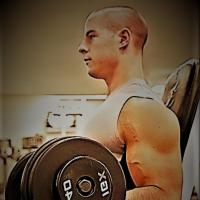Have you heard that it’s impossible to build muscle and lose fat simultaneously? We’re here to debunk that myth because it’s just that — a myth. You know, like Bigfoot or an empathetic billionaire.
The reason behind this myth is the process behind each goal seems contradictory:
- To lose fat, you must be in a caloric deficit, so your body burns your fat as fuel
- To build muscle, you must be in a caloric surplus, so your body has the calories to build the muscles
So if one goal requires eating less and one eating more, that seems like it wouldn’t work well together, right? Nope!
Buckle your seatbelts because this guide will dig into the science to prove you can build muscle and lose fat at the same time.
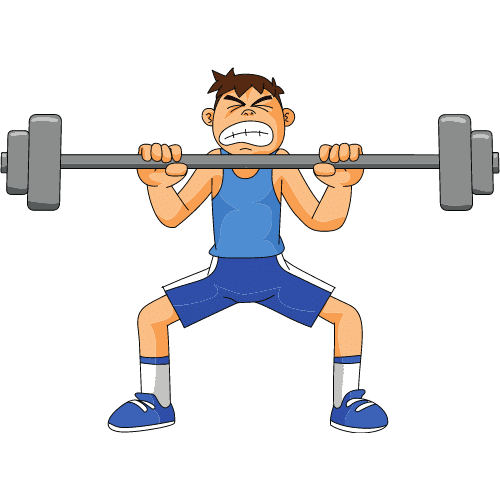
How Do You Build Muscle?
First, the science of muscle building. For a deep, deep guide to this, check out our article How to Build Muscle Fast & Naturally. For the quick-and-dirty version, keep reading.
Eat a Diet Based on Your Goals (with a Caloric Surplus)
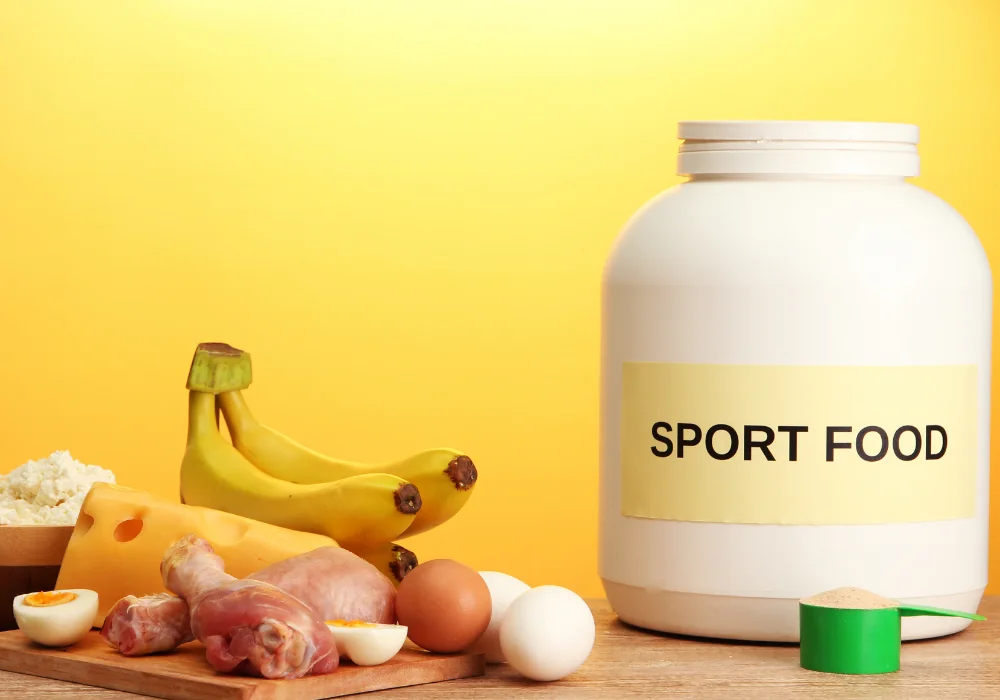
80–90% of your success in building muscle and losing fat lies within your diet. First, set a goal: do you want to build visible muscle (hypertrophy), be able to lift heavier things (strength), both?
Then, dial in your diet. Prioritize fresh, healthful foods as much as humanly possible. Think veggies, fruits, lean proteins, whole grains, and healthful fats.
Yes, that means ditching the processed stuff! There’s a time and a place for that frozen burrito you love, but building muscle, isn’t it. Get real comfy in your kitchen because if you want results, that’s where they come from.
Prioritize a palm-sized portion of protein at every meal (more on protein later). Make sure half your plate is veggies, and about a quarter of your plate is a healthful carb. Limit your healthful fats to about a thumb-tip size.
Some sample meals that are easy to prep and hit these marks:
- Lasagna (make sure to get low-fat ground meat (or veggie meat), whole wheat noodles, and low-fat cheeses. Oh, and cram it full of veggies!)
- Most curries, soups, etc. are excellent, easy ways to cook at home and have food for days
- Grilled salmon with green beans and brown rice
- 3-egg omelet filled with veggies and a sprinkling of cheese, plus a slice of whole-wheat toast
- A salad topped with your protein of choice (fish, turkey, tofu, etc.)
Eating well doesn’t have to be boring. Keep your eyes on your protein and veggies consumption, and you’re halfway there.
TL;DR: Dial in your nutrition with a diet of lean protein, fresh veggies, complex carbs, and healthful fats.
Lift Heavy Things
There’s no way around it: to build muscle, you gotta lift heavy things and put them down again. And again. And again.

Why? Because lifting heavy things puts microscopic tears in your muscles. Your body then has to repair these tears, which means your muscles are stronger and a bit bigger. Rinse and repeat for muscle building.
Now, what if you don’t have access to a gym or weights? Get started with your body weight. Seriously, if you’re brand new to strength training, you will see results with just your body weight.
Eventually, you will need to add weight to stay in what’s called progressive overload (more on that below). The human body is a crazy adaptable machine, and when it adapts to your workouts, you stop making progress.
Invest in a set of adjustable dumbbells if you have limited space. Or go big with a full power rack set up. Or, if you really aren’t able to get your hands on weights, know that your progress will likely be limited, but there are a few options:
- Fill a backpack with heavy stuff to add weight to your squats
- Deadlift with jugs of water (or other heavy household items)
- Add a half rep to your moves (go all the way down into a squat, come halfway up, go back down, then stand all the way up)
- Add more sets/reps to your exercises
- Bench press your child or your dog (safely!)
If you’re serious about building muscle, though, save up for those weights.
TL;DR: To build muscle, pick up heavy stuff and put it back down again.
Focus on Compound Exercises
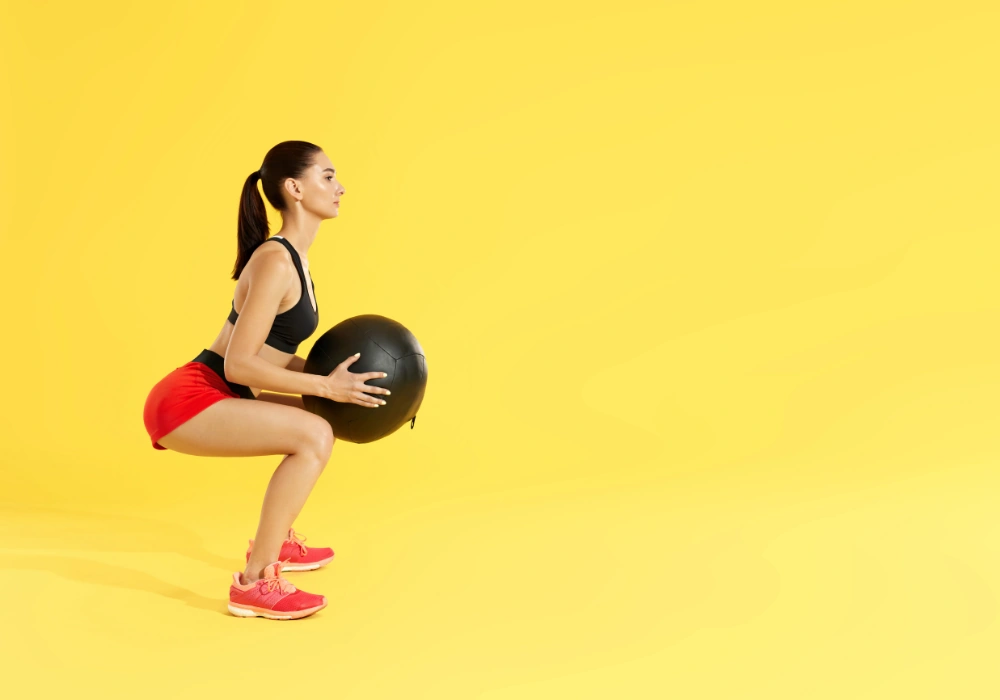
A compound exercise uses multiple joints and muscles to complete. These are the opposite of isolation exercises that use only one joint or muscle.
For example, a squat is a compound exercise. It uses your hips, knees, and ankles. Plus, it works your quads, glutes, and calves (and your upper body a little if you’re using a barbell). On the other hand, a bicep curl is an isolation exercise. It uses only your elbow and works only your bicep.
So, why focus on compound exercises? The short answer is you get more bang for your lifting buck.
Think about it: doing bicep curls, your body doesn’t have to recruit much energy. It’s only working one muscle, so it doesn’t need to work that hard. Doing a squat recruits much more energy because your body has to activate multiple muscles and joints.
Plus, compound moves usually challenge the tiny stabilizing muscles in your feet, ankles, wrists, and hands. So doing compound moves is almost always a full-body experience.
Examples of compound moves to keep in your routine:
- Push exercises: push-ups, bench presses, squats, lunges, hip thrusts
- Pull exercises: pull-ups, deadlifts, rows, reverse flys, face pulls
- Carry exercises: farmer’s walk, waiter’s walk, suitcase carry
- Core exercises/rotations/anti-rotations: Pallof presses, planks, shoulder taps, cable chops, single-leg moves
TL;DR: Prioritize compound exercises over isolation ones.
Progressive Overload
We touched on this earlier, but you gotta stay in a state of progressive overload. Remember how your body is crazy adaptable? Your fitness is no exception.
As you lift heavy things, your muscles get bigger and stronger to help do that work again the next time. So eventually, what you started lifting gets easier and easier until you’re crushing workouts that used to crush you.

The only way to make progress is to keep challenging your muscles in new and exciting ways. A few different methods for this include:
- Add weight to your lifts
- Add extra sets or reps to your workouts
- Add a half-rep on applicable moves
- Slow the eccentric (lowering) part of the move wayyyyy down
- Rest for less time between your exercises
Notice how none of those options included anything about skipping a rest day or training the same muscle on back-to-back days? We’ll dig into rest in a minute, but the reason you shouldn’t train the same muscle on consecutive days is you’re not giving it a chance to recover.
Remember, the work of muscle building doesn’t happen during your workout. It happens in the days after. So if you train legs Monday then again Tuesday, your muscles didn’t have time to rebuild to get stronger before you broke them down again. So space out those muscle groups, people!
TL;DR: Keep challenging your muscles with progressive overload to make, well, progress.
Train Enough Times Per Week
While you might be able to make some progress doing only a single resistance workout each week, you’ll see results much faster if you do at least two. Three is even better.
If you’re doing two strength training workouts per week, either do both as full-body or do a lower/upper split. If you’re doing three, you can do an upper/lower split where your upper body is broken into one push workout and one pull workout.
The point is to make sure you’re working out every muscle in your body with adequate rest days in-between.
TL;DR: Train at least two times per week, but three is better.
Rest (Between Sets, Reps, Workout Days, and Sleep)

Alright, so we’ve learned that real progress happens on your rest days. But “rest” also refers to the pauses between your reps and sets, not to mention your sleep (though we are going to mention it because it’s essential).
How much you should rest between sets and reps is a huge topic. (Huge enough, we wrote a complete guide about it.) But here’s the nitty-gritty.
Reps refer to repetitions of the move you’re doing. A single rep of a squat, for example, is starting from standing, descending into the squat, and returning to standing.
Sets refer to how many repetitions of each exercise you do. So, for example, if you do even two bodyweight squats back-to-back, that’s technically a set.
You should aim for minimal (read basically no) rest between reps. Unfortunately, there’s not much scientific research on how much you should rest between sets. In general, the shorter your rest period, the higher your heart rate will get during your workout. The longer your rest, the more you’re recovering.
If your goal is to build muscle, you’re better off erring on the side of lifting heavier, so you rest for longer.
Now, we’ve already covered workout days, so let’s talk about your sleep.
Sleep is where your body does about a million different things to repair you and restore your body. Part of what it does is repair those muscle tears we talked about earlier. So the better quality and longer sleep you can get, the more efficiently your body can repair itself. That means a stronger you, more quickly.
TL;DR: Rest not at all between reps, for at least a minute between sets, alternate what muscles you work out on what days, and for the love of all the fitness gods, get enough sleep.
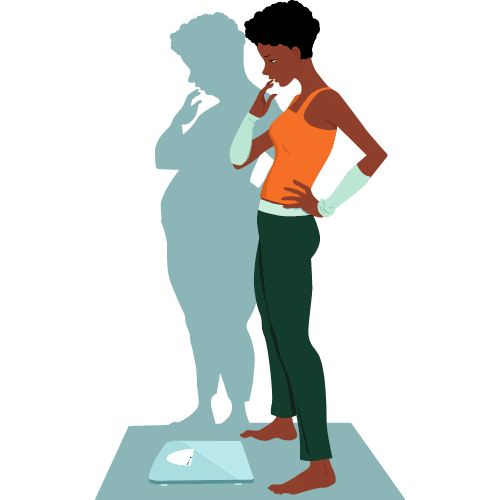
How Do You Lose Fat?
If you guessed that we have an extensive article on how to lose fat, you win! But to cover the basics, keep reading.
Figure Out Your Daily Recommended Caloric Intake

Remember how you need to be in a caloric deficit to lose fat? That means you’re consuming less calories than you’re using throughout your day. But to get there, you need to know how many calories (how much energy) your body uses during the day just by existing.
That’s right! The good news is even on rest days, your body uses energy to do things like keeping your heart beating, your liver functioning, your brain thinking, etc. So, how many calories does your body use to do these things?
Use a calculator like this one to determine your Total Daily Energy Expenditure or TDEE.
Once you know how many calories you use each day, you can start eating in a deficit to lose fat.
TL;DR: Figure out your TDEE so you can calculate your deficit.
Be in a Caloric Deficit
You may have heard the old “weight loss is all about calories in vs. calories out” routine already. For most people, that’s the long and short of it.
If you eat more calories than your body uses, your body stores those in the form of fat to use later on. So if you continuously do this, you continuously gain weight.
On the other hand, if you’re consistently eating less than your body uses, your body has to turn to those stores for fuel. That’s how you lose weight.
But how do you achieve this deficit? Should you exercise more or eat less?
Let’s look at an example. Say your TDEE is 2100 calories. You want to be in a caloric deficit of 300 calories, so you should aim to consume about 1800 calories per day.
To achieve that 300 calorie deficit, you’d have to hit the cardio machines for anywhere from 30 to 60 minutes every single day. On the other hand, you could just not eat a single bagel, and boom! 300 calories gone from your diet.
It’s important to note that you should be in a slight caloric deficit. For example, don’t go from 2000 calories per day down to 1000. Not only is that not enough food for a freaking toddler, let alone a full-grown adult, but your body will drastically slow down the rate at which it uses calories.
TL;DR: Aim for a 300–500 caloric deficit below your TDEE to lose weight.
Go All-in on Cardio
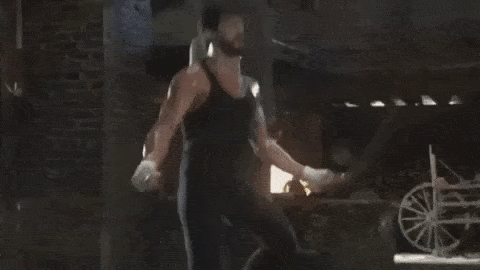
To build muscle, you lift weights. To lose fat, you can also lift weights, but cardio is key.
Cardio workouts (generally) last longer than resistance workouts, meaning you’re burning more calories during them. Also, there isn’t really a need to skip an entire muscle group or swap days when you do cardio. (Know that one fitness buff who goes for a run every single day? Yea, like that.)
Plus, while there are effective variations for exercises (goblet squats, barbell back squats, front squats, etc.), you’re still working the same basic muscle groups in the same way. With cardio, there are many options to shake things up and burn more or less calories.
First, everyone should be going for at least a 15-minute walk every single day. Seriously. The health benefits of literally just walking are practically endless. It can not only help you lose fat but also strengthen your bones and muscles, improve your mood and cognition, reduce stress and tension… you get the idea.
In addition to walking, you can do steady-state cardio like going for a run. Or, you can do high-intensity interval training (HIIT) for shorter time periods.
Why is cardio so effective for fat loss? First, it helps to know a bit of the science. Now, this will vary from person to person based on a lot of different factors (genetics, age, previous activity level, etc.). But, in general, after anywhere from 30–60 minutes of cardio work, your body turns to its stored glucose (fat) for fuel.
TL;DR: Cardio is key for fat loss. Prioritize it in your routine.
Avoid Empty Carbs
This section will be a bit of a downer if your daily diet consists of white bread, cookies, pizza, or bagels. Sorry, folks — those empty carbs gotta go.
Empty carbs, also known as simple carbs, are digested quickly. This causes a spike in blood sugar, not to mention contributing to your risk of diabetes, heart disease, and high cholesterol. It’s basically like dumping a big old bowl of sugar directly into your blood.
Now, it’s important to note I’m not saying simple carbs are “bad.” There are no “good” or “bad” foods, and we need to stop moralizing them as such. Simple carbs are bad for you, for your health, but you are not bad for eating them.
I’m also not saying you can literally never eat another cookie or slice of pizza again. Like so many things in the world, your diet is about balance. So let yourself have the dang cookie if you want it. If your diet is like 80% simple carbs, that’s gotta change if you want to lose fat.
Instead, swap those simple carbs for complex ones. Fruits and veggies are a great place to start. Prioritize whole grains like whole-wheat bread, quinoa, brown rice, and oatmeal. Complex carbs digest slowly in your body, avoiding the blood sugar spike. Plus, they almost always come with the fiber, vitamins, and minerals your body needs.
TL;DR: Swap simple carbs for complex ones.
Switch to Healthful Fats
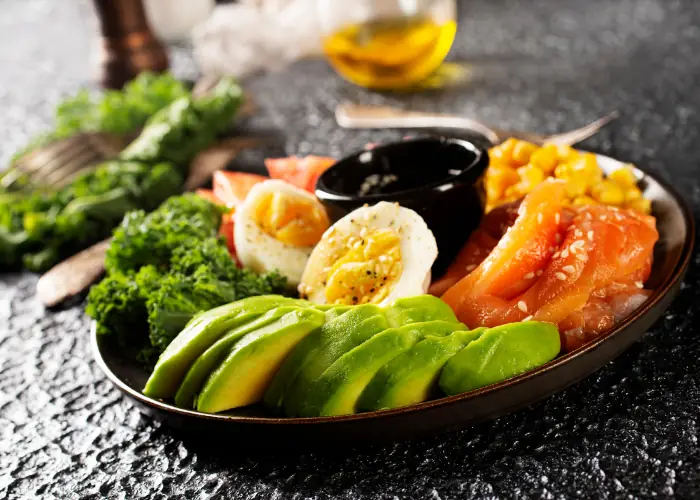
Another potential downer here: not all fats are created equal, and the unhealthy ones need to be eliminated from your diet. The good news is healthful fats absolutely need to be included!
There are four main types of fats:
- Saturated
- Trans fats
- Monounsaturated
- Polyunsaturated
Unhealthy fats (saturated and trans) are the ones that are solid at room temperature. They raise your cholesterol and contribute to heart disease. Healthful fats (mono and poly) are liquid at room temperature and lower your cholesterol.
Examples of unhealthy fats to avoid are fried foods, margarine/butter, shortening, baked goods, and processed snacks. Try to eliminate these completely from your diet. Fats to limit include butter, tropical oils (coconut, palm), fatty cuts of meat, dark chicken meat, and poultry skin.
Alright, we’ve covered what you can’t have or should limit. What can you have? The good news is, a lot!
Add these healthful fat-containing foods to your diet (but remember, a thumb-tip size portion per serving):
- Nuts and seeds (almonds, walnuts, cashews, flaxseed, chia seeds)
- Vegetable oils (olive and peanut)
- Nut butters
- Avocado
- Most fish (salmon, herring, sardines, trout)
- Canola oil
- Tofu
- Soybeans/edamame
Healthful fats contain essential omega-3 fatty acids, which not only improve your heart health but can help shrink your waistline.
TL;DR: Swap unhealthy fats for healthful ones.
Avoid Sugar and Processed Foods
We’ve sorta hit this one, but it bears repeating: avoid sugar and processed foods if you want to lose fat.
Watch for sneaky ways sugar is getting into your diet, too. Think that third cup of coffee, that second glass of wine with dinner, or the fruit and nut bars you thought were a healthful choice.
If you see words like sugar, fructose, cane sugar or juice, sucrose, honey, molasses, maple syrup, fruit juice, brown rice syrup, high fructose corn syrup, or agave on the ingredients list of your food, that’s all added sugar.
Processed foods are often high in added sugar, sodium, and preservatives. Think those oh-so-convenient premade dinners, frozen pizzas, or ready-to-eat foods like crackers and chips.
Again, I’m not saying to eliminate these completely. Just consume them in extreme moderation.
TL;DR: Avoid added sugars and processed foods for successful fat loss.
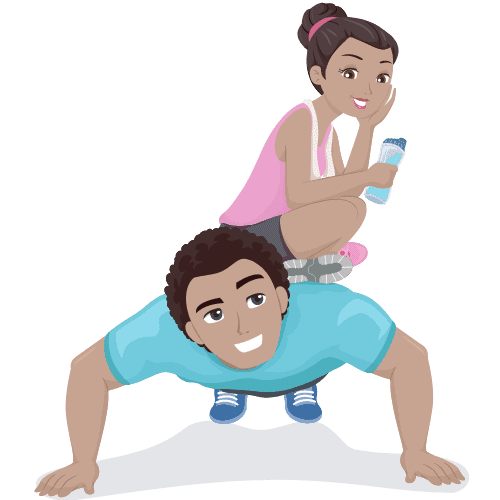
Okay, So How Do You Do Both At The Same Time?
The info above might seem a bit contradictory, but don’t worry, we’ll explain exactly how to build muscle and lose fat simultaneously.
First, an Intro to Body Composition

Your “body composition” is the various percentages of muscle, fat, water, and bone you have in your body. It’s important to know your starting composition because it’s a much better indicator of your health than looking at weight alone.
Plus, trying to lose fat and build muscle simultaneously means you need to know how much body fat and muscle you’re starting with. This leads us to our next subject: body recomposition.
And to Body Recomposition
Body recomposition is the holy grail of what this entire article is about. It’s the magic place where you’re building muscle and burning fat at the same time. It’s watching those percentages shift in the direction you want.
It’s important to note that during body recomposition, you might not actually lose any weight. In fact, because muscle is more dense than fat, you might weigh more. This is 100% okay and nothing to worry about because you’re, well, losing fat and gaining muscle.
Can Anybody Do It?
Basically, yes, anyone can pursue body recomposition. There will be a few factors to consider, though:
- Genetics. If you’re genetically predisposed to carrying a lot of fat instead of muscle, you’ll likely need to work much harder and might not see as great of progress.
- Environmental factors. If you don’t have much equipment, don’t live near stores with healthful foods, or don’t have the financial means to access healthful foods, body recomposition might also be a bit difficult for you.
- Training levels. Newbies to exercise will see results more quickly than folks who are already training. However, even seasoned lifters can enjoy body recomposition.
It can’t hurt to try, so use this guide and give it a go!
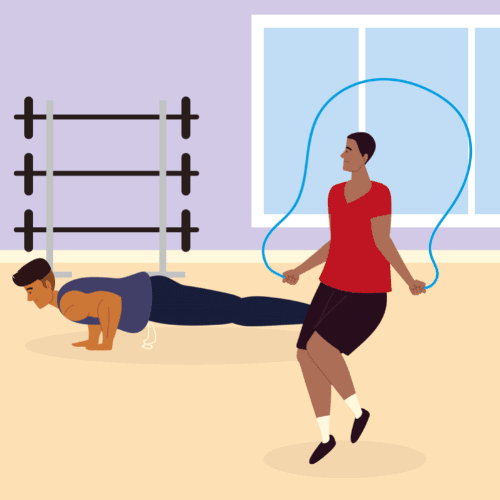
Here’s How You Do It
It’s Not About Weight Loss

I mentioned this above, but it bears repeating: body recomposition is not about weight loss. You might not lose weight at all, and you might even gain.
If your goal is to simply watch the scale go down, this guide is not for you. Unless your doctors have medically advised you to lose weight, I’d like to gently encourage you to dig into your “why” behind a simple weight loss goal. Why would you want the scale to go down if you’re losing muscle, too?
So, your best bet is to ditch the scale, but if you must weigh yourself, use it as only a single factor (which is good health advice anyway).
Make Sure You’re in a Calorie Deficit
Yep, we’re saying this one again, too. You need to be tracking your calories to make sure you’re in a caloric deficit. You simply don’t lose fat unless you’re using more calories than you’re consuming.
Every day when you eat, your body has three choices for what to do with those calories:
- Use them as fuel
- Use them to rebuild muscle
- Store them as fat
When you’re strength training regularly so, your muscles need rebuilding, but you’re not eating enough to both fuel your body and do that, what happens?
Your body turns to its already-stored fat! That’s how you build muscle while being in a caloric deficit. Your body uses the calories it’s getting to rebuild your muscles or as fuel and uses the stored energy for everything else.
Prioritize Protein
Remember how protein is the primary structural component of your cells? It’s what your body turns to when it needs to repair itself. So, prioritizing protein in every meal and snack — while being in that caloric deficit — ensures you’re giving your body the nutrients it needs to repair your muscles, thus making them stronger.
Plus, protein helps with feelings of fullness. So if you struggle with overeating carbs or fats, swapping your focus to protein will help you feel full more quickly. Hello, built-in calorie-reduction tool.
AND protein is more energy expensive, which means your body uses more energy to digest it than it does for carbs or fats. So basically, you’re burning more calories in the digestive process simply by eating protein.
Bet you didn’t know protein was such a powerhouse of a nutrient, huh? Aim for about 1.4–1.7 grams per kilogram of body weight (0.6–0.8 grams/pound). Spread this throughout your roughly three meals and two snacks. And remember, a serving is roughly the size of your palm.
Choose Your Carbs Wisely = Empty Carbs

I never advocate for eliminating an entire macronutrient from your diet. It’s too restrictive, plus your body needs all three (protein, carbs, and fat) to function. So I’m not saying cut carbs. Just choose them more carefully.
Remember to look for complex and whole-grain options. Ditch the white rice and store-bought cereals, people. Think whole wheat bread/wraps, brown rice, quinoa, lentils, barley, etc.
Also, while a cooked serving is two cupped handfuls, you might want to reduce that a little. Experiment with portion sizes to find what makes your body feel energized.
Go Hard & Heavy
In the muscle-building section, we talked about progressive overload and lifting heavy. That is absolutely key when trying to build muscle.
How heavy should you lift? That’s a bit complex, so we wrote an entire guide about it. Here’s the basics:
Start with your body weight (yes, really!). Especially if you’re new to lifting, it’s absolutely essential, to begin with only your body weight to ensure your form is solid.
If your form is wrong, when you add weight, there are a couple things that will go wrong. The first is that you risk injury. For example, if you’re trying to deadlift but don’t have the proper form, you risk using your weak lower back muscles instead of your powerful hamstrings. Say hello to a pulled-back muscle.
Second, you risk not working the muscle you’re trying to target and wasting all your time in the gym.
So, unless you’re a seasoned lifter whose form has been checked by a personal trainer, start with bodyweight. Then, add very lightweight. Like, five pounds tops. (Trust me, this slow beginning will pay off later.)
You’ll know you can lift heavier when you’re regularly completing your sets and reps, feeling like you could do at least three more reps with absolutely perfect form.
In the beginning, up your weight by no more than five pounds. Then, as you progress, you can add more weight more quickly.
One critical note about going hard: you should never, never be in pain during your lifts. Pain is your body’s way of telling you something is wrong. So don’t ever push through pain. (That’s right, throw “no pain no gain” right out the goddamn window.)Soreness, on the other hand, is likely if you’re pushing yourself. Light to moderate soreness during or after your workouts is normal. But if you’re going so hard you can’t walk the next day, it’s time to dial it back a bit.
Another important note: try to keep your head in the game. What I mean by that is, focus on the muscle you’re trying to build as you’re completing each rep. This is called the mind-muscle connection, and research backs it up.
When you think only about the muscles you’re working, science has shown they get stronger than people who aren’t staying mentally present. So what does this focus look like? Here ya go:
- Move slowly. Lift for two seconds, pause your lift for one second, then return to your starting position for three seconds.
- Lift with your eyes closed. Visualize the muscle fibers contracting and relaxing. (Note: don’t attempt this if you have balance problems, are lifting really heavy, or are performing an exercise that needs a spotter.)
Focus on those muscles and watch ‘em grow.
TL;DR: Start with your body weight, then progressively add weight until you’re lifting heavy. Never feel pain and practice the mind-muscle connection.
Go Easy with the Cardio
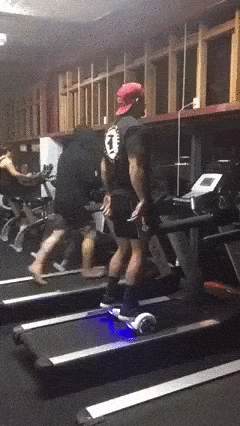
Remember, our goal isn’t to lose weight but to lose fat and gain muscle. If you’re spending 60 minutes three times a week on the treadmill, you’re going to struggle with this goal.
We know building muscle usually relies on a caloric surplus and losing fat relies on a caloric deficit. So if you’re doing hours of cardio each week, you’re more likely to be in a deficit but too big of one.
Your body won’t have the energy it needs to repair and build your muscles.
So swap your endless plodding for something more fun (and shorter). Think two or three 20–30 minute HIIT workouts each week or two HIITs and vigorous yoga. Oh, and never forget the value of walking. Everyone should take at least a 20-minute walk every single day.

How Do I Know All This Stuff Works?
Like so many things in life, you’ll only know if you’re tracking your progress. There are three key ways to do this:
- Weigh yourself. This is the first and least important stat, but it can help with painting the bigger picture. Make sure to weigh yourself only once per week at exactly the same time and conditions (i.e., when you’ve first woken up, used the bathroom, and haven’t had any water or food yet).
- Take progress photos. Because your weight might not change, progress photos are a better way to measure. Wear whatever level of clothing you’re comfortable in (though less will help you see progress better). Take a photo from the front, sides, and back, keeping your arms straight out in a T. Then, after two or three weeks, take another set and compare them. Make sure to use the same clothing and lighting!
- Take measurements. Another excellent way to see progress is with measurements. As you burn fat and build muscle, you should become more physically lean. Measure around your biceps, chest, waist, butt, and thighs. Follow similar timing to progress pictures.
If your nutrition is good, you’re lifting heavy a few days a week, getting adequate rest, and still not making progress, it’s time to look at a few things.
TL;DR: Track your progress. If you’re not seeing results, check out the following sections.
Did You Cut Calories?
So many people overestimate the amount of calories they consume in a day. Make sure you’re tracking everything, including the splash of creamer in your coffee and that handful of mixed nuts you take when you enter the kitchen.
It’s really helpful to use an app like MyFitnessPal to ensure you’re staying in a caloric deficit. Keep in mind, though, that nutrition labels aren’t 100% accurate. So there will be some estimating involved. Just do your best to stay in a 300–500 calorie deficit.
If you’re still not seeing results after two or three weeks, try dropping your calories by another hundred. Don’t take it from your protein, though! Instead, cut your carbs and/or fats.
TL;DR: Track your calories and make sure you’re in a deficit.
Are You Lifting Enough?
Remember that one strength day a week isn’t going to cut it. Similarly, only lifting for 10 minutes three times a week isn’t great either.
You need to have at least two (three is better) lifting days each week for at least 30 minutes per workout. Of course, 45 minutes is better, but if you can only get in 30, that’ll do.
Now, I want to emphasize that any movement is better than no movement.
So if you have a few days where you just can’t do anything beyond 10 minutes, do those 10 minutes. Just don’t let it become a habit to skate by on your lifting.
Also, make sure the weight you’re lifting is heavy enough that when you reach the end of your sets, you can’t do any more with good form. Push to failure with every workout. Note: I said can’t do any more with good form. Never sacrifice form for failure.
TL;DR: You can’t build muscle without lifting. Make sure you’re working out for long enough and lifting heavy enough.
Do You Prioritize Protein?
This is another place where tracking your food is key. You have to prioritize protein at each meal and snack to build muscle and lose fat simultaneously.
The palm-size serving method is a great estimate, but if you’re not making progress, try actually tracking the grams throughout your day. You might find that you’re eating more carbs or fat than you intend to.
If this is the case, up your protein intake. Not sure how? Try a bigger serving size at main meals, and make sure your snacks are as close to 100% protein as you can. Here are some ideas:
- Jerky or dried meat
- Rolled up deli meat (vegetarian options work too)
- Protein bars or shakes
- No-fat Greek yogurt
- Baked tofu slices
TL;DR: Check your protein levels to ensure you’re getting enough.
Do You Get Enough Rest?
This is another place where it’s so easy for people to mess up. Make sure you’re not training the same muscles on back-to-back days. Work at least two rest days into your training weeks (though low-impact activities like yoga and walking are still great to do).
And make sure your sleep hygiene is 100% on point! Things to look for or implement in your routine:
- No screens for at least 30 minutes before bed. Yes, really, turn them all off! Instead, try journaling, reading a book, or doing gentle nighttime yoga.
- Keep your bedroom cool and dark.
- No alcohol before bed. Alcohol messes with your REM sleep, which is when your body’s doing a lot of the repair work. Skip the nightcap.
- Stop caffeinated beverages around 3pm.
- If you can’t sleep, consider over-the-counter solutions like magnesium or melatonin (get your doctor’s permission first).
TL;DR: Resting and recovering are key, so make sure these areas are on point.

Wrapping It Up
Building muscle and losing fat may seem like a dream, but in reality, it’s a goal you can achieve. Stay in a slight caloric deficit, lift heavy things, and definitely make sure your nutrition is on point.
Get ready to enjoy a newly recomped body, friends!

